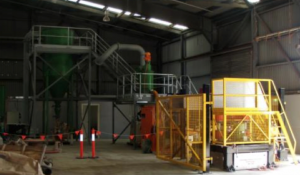PCC Seeks Control over Comminution’s Environmental Effects
BY Sandy Lender

IMP Technologies (IMPTEC) of Adelaide, Australia, has developed a super fine crusher that is designed to reduce comminution costs and the energy associated with producing material for ordinary Portland cement (OPC). Spokesperson Chris Kelsey explained the piece of equipment will not be displayed outside of Australia until license agreements have been finalized, but the company has a semi-commercial unit on trial at Hallett Concrete in Adelaide now, turning the waste from black sand—or iron sand—into a replacement for Portland cement. There are reports that this transformation of black sand or granulated slag into cement is a world first.
Amit Kumar from the Norman B. Keevil Institute of Mining Engineering-University of British Columbia prepared a report on the basics of comminution for the technology.infomine.com website in which he explains, “Comminution is the process in which the particle size of the ore is progressively reduced until the clean particles of mineral can be separated by such methods as are available.” He included recent developments in comminution, including information on the high pressure grinding rolls (HPGR) adapted in the cement industry, which use compression breakage of a particle bed, in which energy efficient inter-particle breakage occurs. “The reduction ratio obtained in a single pass through the HPGR is substantially higher than that obtained in conventional rolls crushers,” Kumar wrote. He included that there is some evidence for downstream benefits of HPGR, but there are other methods hitting the market.
 Mark Drechsler, a consulting engineering geologist for WorleyParsons Services Pty Ltd of Adelaide, Australia, spoke at the XXVII International Mineral Processing Congress in Santiago, Chile, suggesting that implementation of super fine crushing for the cement industry could replace ball, hammer or vertical roller mills in cement plants. He suggested that running two or three super fine crusher modules in parallel could process a wide range of materials while reducing operating costs, lowering energy consumption and reducing startup power loads on networks.
Mark Drechsler, a consulting engineering geologist for WorleyParsons Services Pty Ltd of Adelaide, Australia, spoke at the XXVII International Mineral Processing Congress in Santiago, Chile, suggesting that implementation of super fine crushing for the cement industry could replace ball, hammer or vertical roller mills in cement plants. He suggested that running two or three super fine crusher modules in parallel could process a wide range of materials while reducing operating costs, lowering energy consumption and reducing startup power loads on networks.
That’s where IMPTEC’s equipment comes in.
IMPTEC Director John Doherty said, “What we’re involved in is reducing the amount of energy, which is usually electrical, and the cost of media,” Doherty said. “You can also include lower maintenance costs because it’s just one machine. The energy density of the crusher is greater than other machines and reduces around 30 percent of energy costs.”
The machine shortens the comminution process by merging its second and third stages—combining the crushing/grinding of minerals. It is unique because it will be able to run the process dry and without the use of media. At this time, it’s doing so at a “slow” rate that IMPTEC would like to increase.
“Our semi-commercial unit takes in orders of two tonnes per hour,” Doherty said. “If it approves itself over the next few months, it would be good. We’re looking at scaling up to 100 tonnes per hour.”
The University of South Australia’s Future Industries Institute Bill Skinner said, “This particular technology offers much reduced energy consumption. Up-scaling it is a challenge that needs to be overcome.”
—
Reduce GHGs
4 billions tonnes of ordinary Portland cement created in 2013 represented the second largest source of greenhouse gas (GHG) at 0.65 to 1.1 t CO2 per 1 t OPC production. Researchers seek to reduce both costs and environmental ravages by:
- Improving OPC production efficiencies;
- Improving OPC reactivity;
- Increasing the use of supplementary cementitious materials (SCM); and
- Replacing OPCs with geopolymer concrete.
Source: Drechsler, IMPC2014
